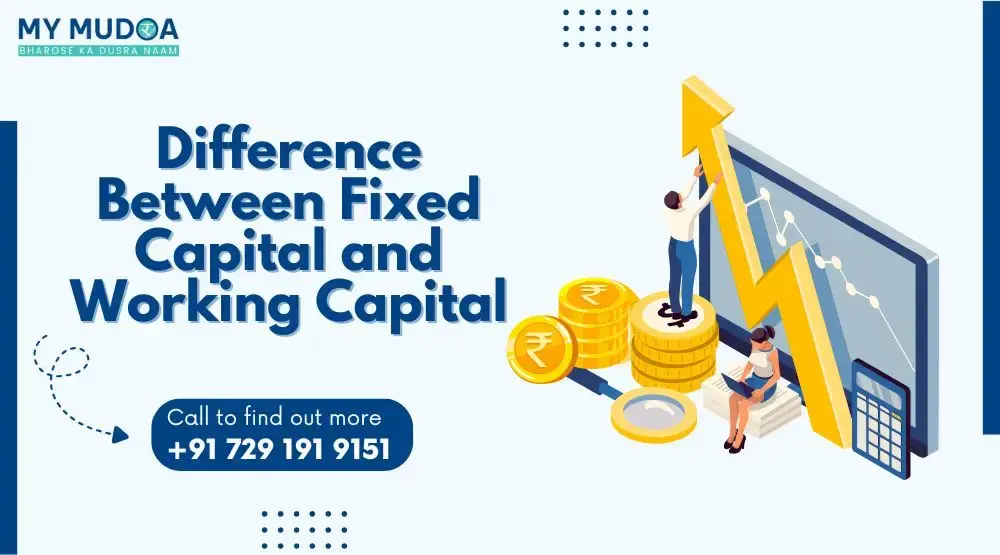
"Understand the difference between fixed capital and working capital. Learn how to distinguish between the two with clear examples. Read our blog to know more."

Published: 24 July 2025
Updated: 8 October 2025
We all know that we need capital to start a business. But there are two types of capital, one of which is called fixed capital, and the other is called working capital. But which one is what? Well, there is a major difference between fixed capital and working capital, and it is important to know them better. In this article, we’ll be diving deep into working capital and fixed capital to understand their uniqueness.
Fixed Capital (FC) is the money that a company invests in its long-term assets, or belongings. It is a must for a business in its early stages, whether to start a new business or run an existing one. It is the part of the whole fund that isn't used for making things but is kept in trade for more than one accounting cycle. It exists in the company's intangible and tangible assets. It includes buildings, plants, machinery, vehicles, and other structures. Companies usually write off fixed-capital assets over a long period of time in their financial statements.
However, the Section 179 deduction sometimes lets them write off the entire amount in one go. You need to know what an asset is for in order to figure out which ones are fixed capital.
Moving ahead in evaluating the difference between working capital and fixed capital. It's time to comprehend Working Capital (WC). Well, it measures how economically sound and useful the company is. It is used to pay for an organisation's short-term business activities. It’s the difference between current assets and current liabilities.
Current assets are things that can be turned into cash within a year, such as cash, debtors, inventories, and so on. Current liabilities are things that will be paid off within a year, such as bank overdrafts, short-term loans, tax provisions, creditors, and so on.
Using working capital can help a business grow, pay off debt, and make money. When small business owners run out of working capital, they often use working capital business loans to fill in the gaps.
Now, you have understood the basic meaning. Let’s understand the difference between fixed capital and working capital from the table below.
|
Basis |
Fixed Capital |
Working Capital |
|
Definition |
Investment in an organisation's long-term assets. |
Investment in a company’s current assets and liabilities. |
|
Kinds of Assets Acquired |
Used to purchase non-current assets (e.g., land, machinery). |
Used to purchase current assets (e.g., inventory, raw materials, cash). |
|
Liquidity/ Conversion to Cash |
Not liquid – cannot be easily converted to cash. |
Highly liquid – easily convertible to cash. |
|
Term |
Long-term – serves the business for an extended period. |
Short-term – serves the business for daily operations. |
|
Accounting Period |
Benefits extend beyond one accounting period. |
Benefits are confined to a single accounting period. |
|
Objective |
Aims at strategic or long-term business goals. |
Aims at meeting short-term operational needs. |
|
Consumption in Business |
Indirectly helps the business (e.g., through infrastructure). |
Directly used up in the business’s day-to-day functioning. |
|
Interesting Fact: Fixed vs Working Capital |
Both fixed and working capital are necessary for a company’s survival, and by understanding the difference between fixed and working capital, though they’re not exactly opposite to each other, together, they’re referred to as “Total Capital”
Also, saying that one is more important than the other is wrong. Working capital makes sure that the company's fixed assets are used in a way that makes money. But you can't start a business without some fixed capital.
So, every business needs to pay close attention to both of them. It's also important to invest in the right assets that the company can often use and make money from. If you need capital to invest in your business, My Mudra has your back. We help you get the best working capital loans and fixed capital loans by giving a competitive analysis of different options. We ensure that you get a prompt business loan with minimal paper requirements with ease.
Also Read:
- Importance of Working Capital Loan for MSME in 2025
- Most Profitable Business Ideas in India 2025
Ans: To find out how much working capital a company has, you take its current assets and subtract its current liabilities. This difference shows how much money a business has to pay for its daily operations and short-term debts.
Ans: Fixed capital is very important for a firm. It makes a company's long-term investments in things like buildings, machinery, and equipment that are necessary for production, operations, and growth. These assets help a business to become more efficient, lower its costs over time, and grow its operations, all of which help it stay competitive and successful in the long run.
Ans: In general, no, you can't turn fixed capital immediately into working capital. Fixed capital is money that is tied up in things like land, buildings, and machinery that are used for business and can't be simply turned into cash.
💬 Comments
Leave a comment or ask a question!
Please Enter Your Name
Please Enter Your Email
Please Enter Your Phone
Please Write Your Comment